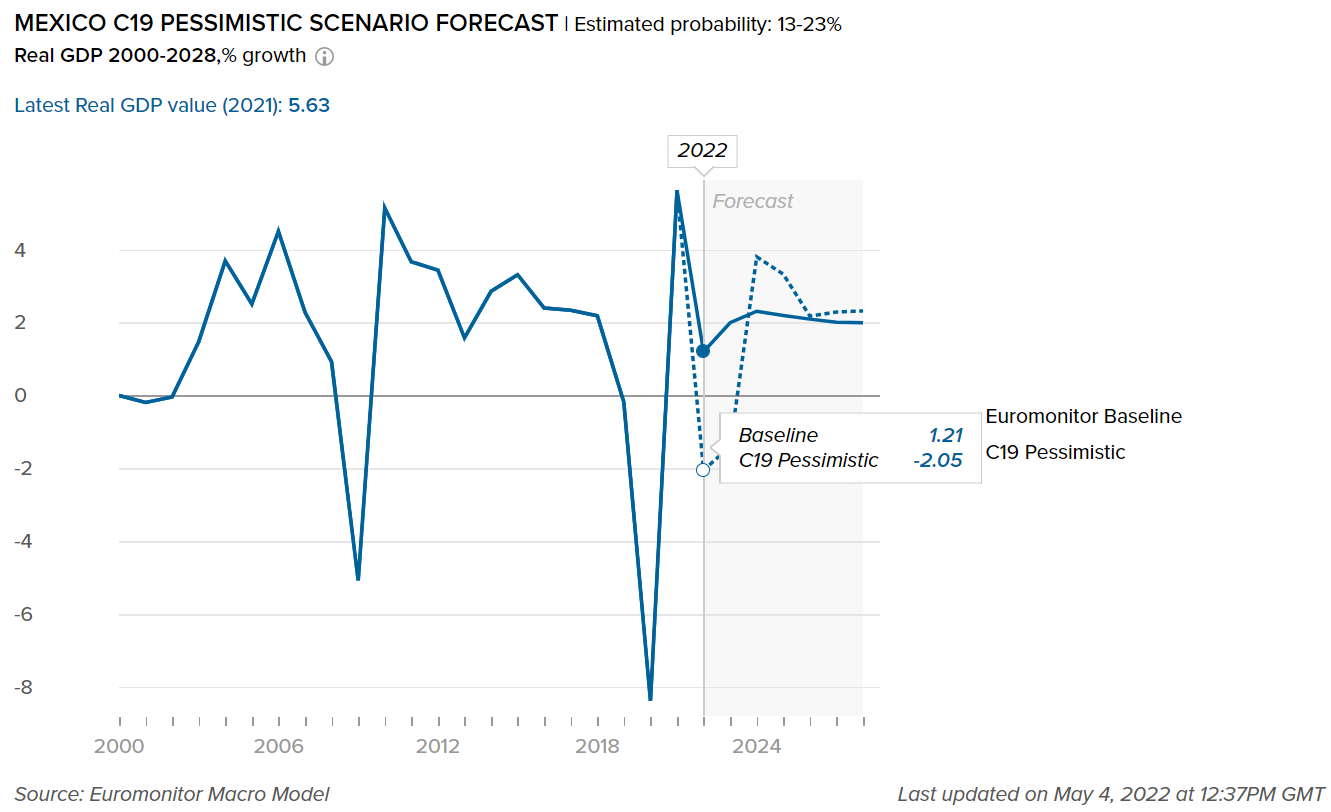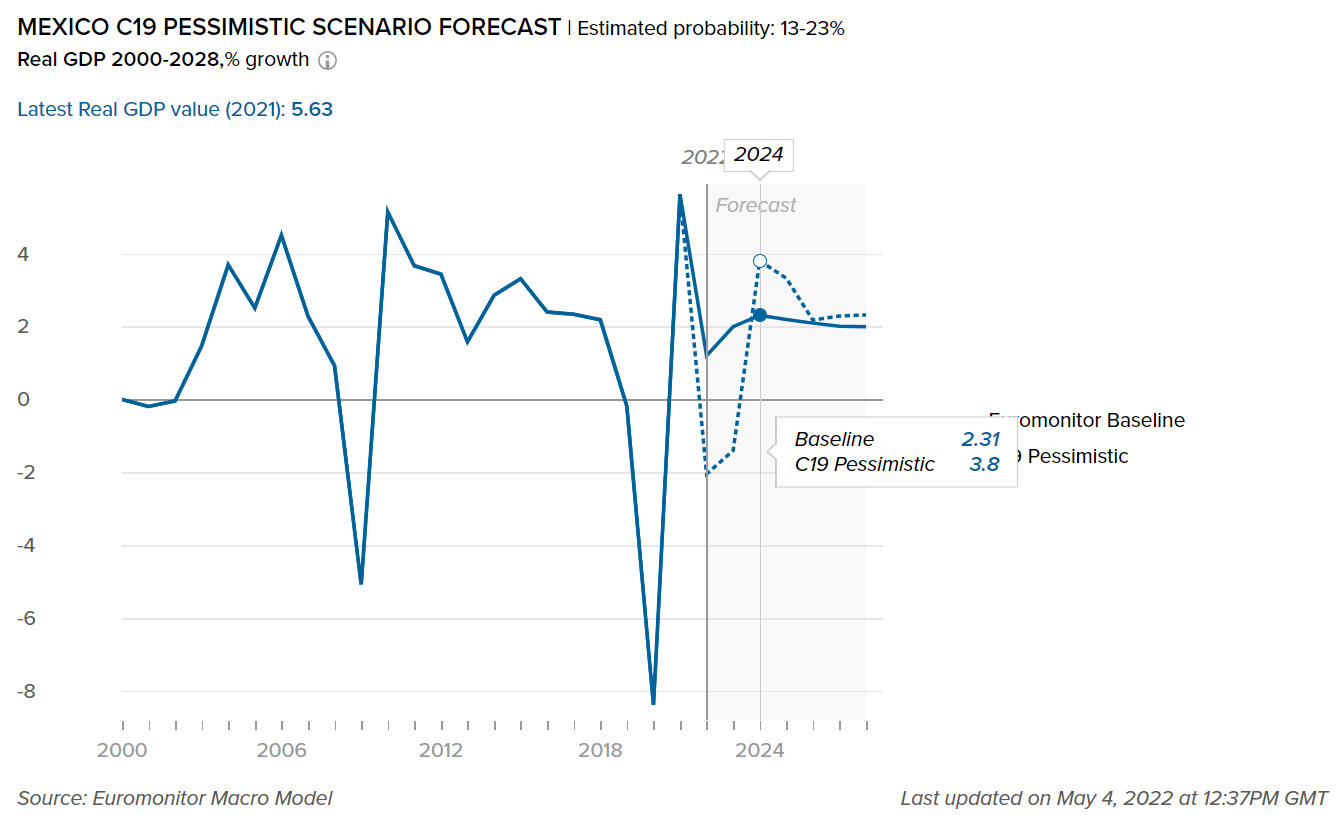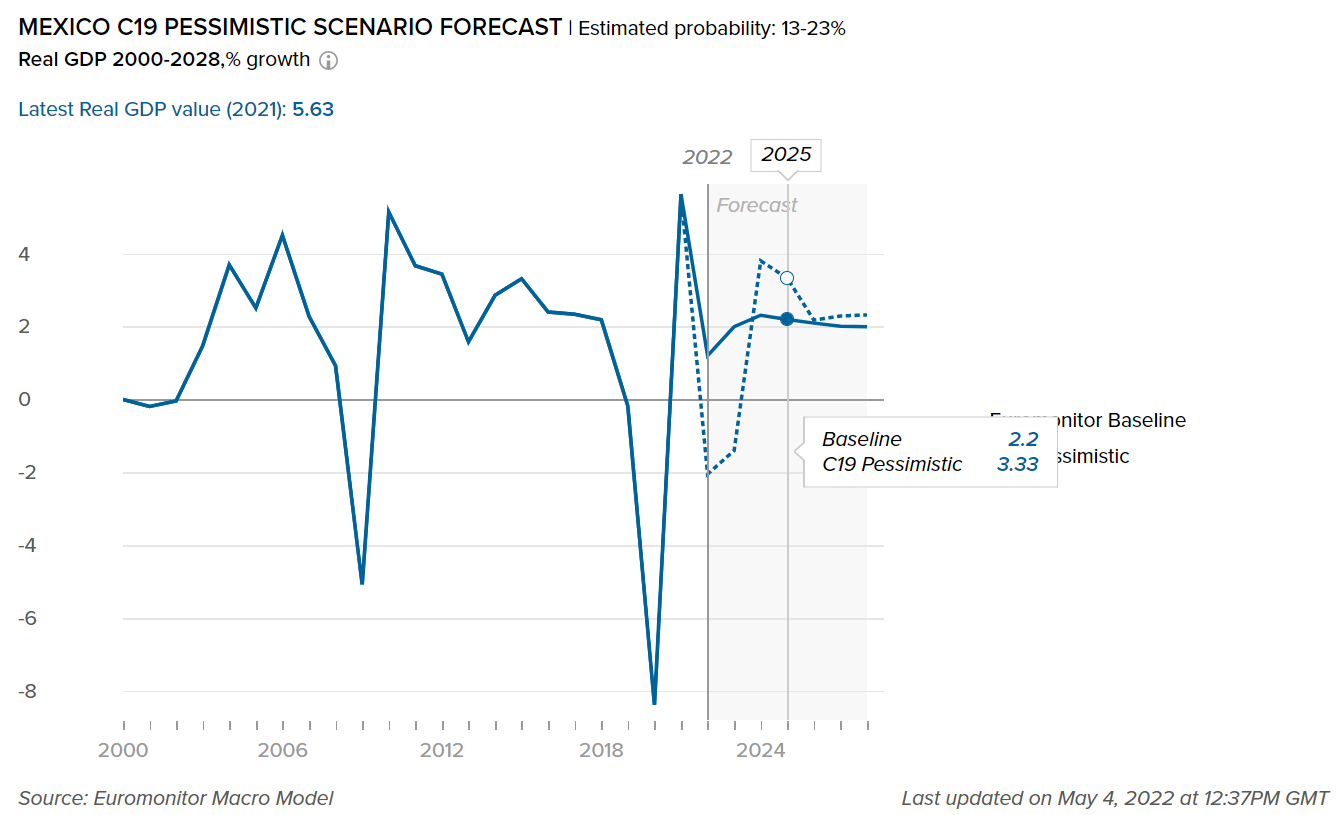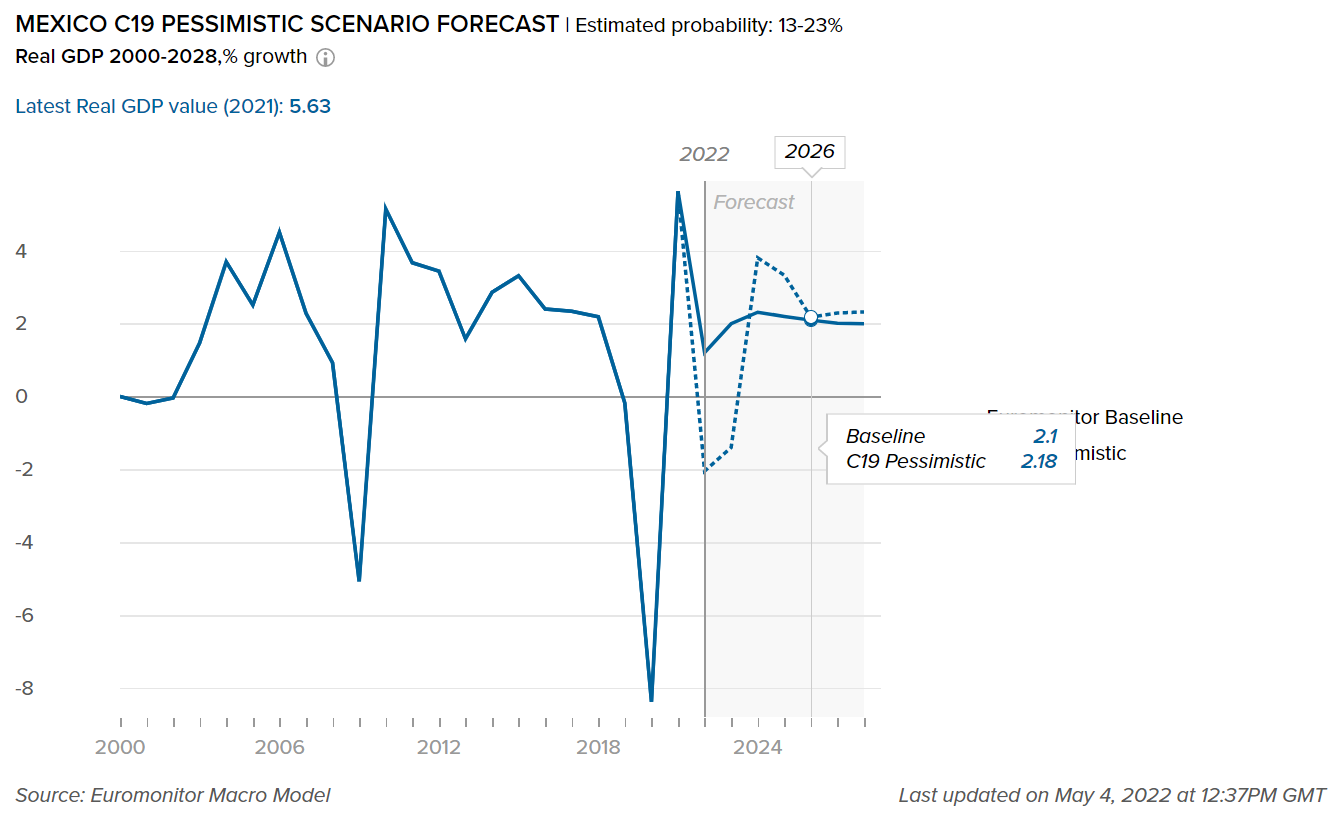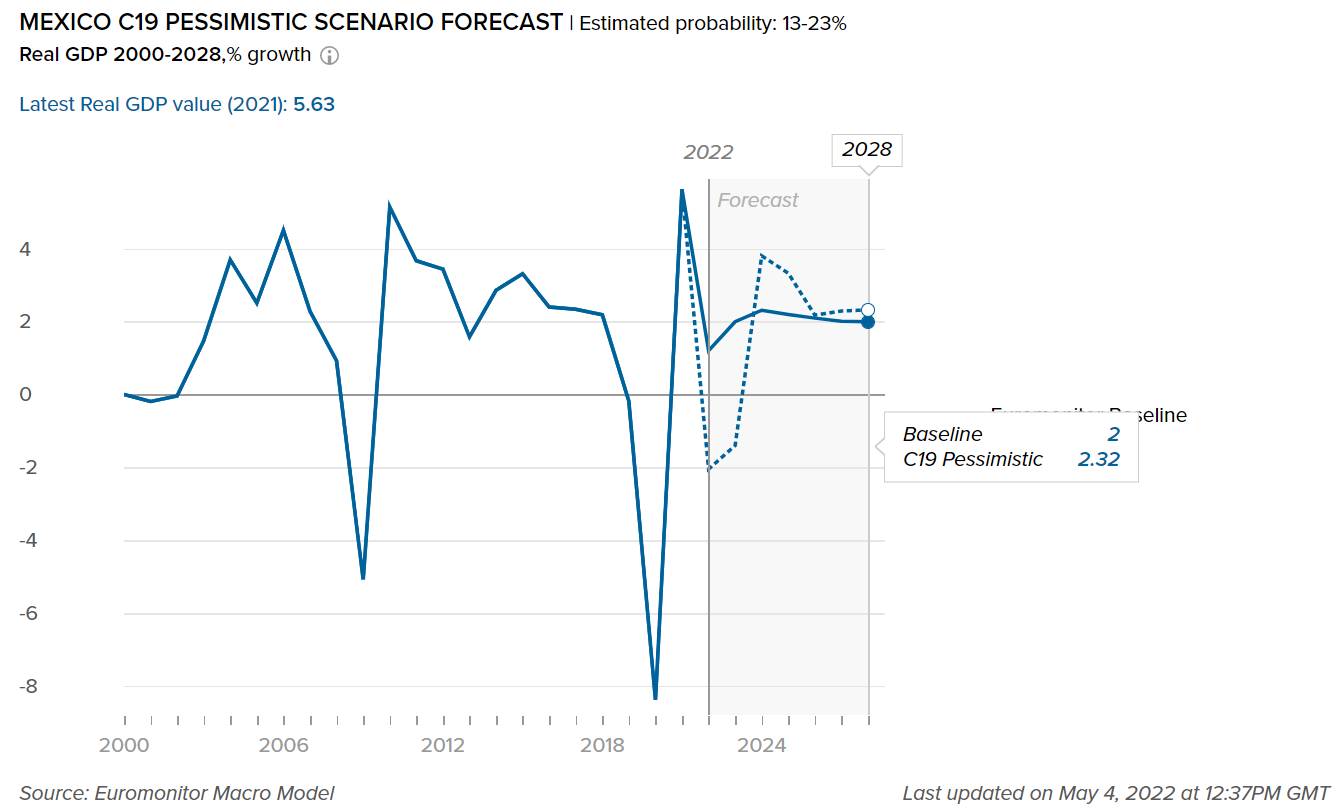Overview
- Packaging Overview
-
2020 Total Packaging Market Size (million units):
124,082
2015-20 Total Packaging Historic CAGR:
2.5%
2021-25 Total Packaging Forecast CAGR:
-0.8%
Packaging Industry
2020 Market Size (million units)
Beverages Packaging
50,455
Food Packaging
64,347
Beauty and Personal Care Packaging
4,742
Dog and Cat Food Packaging
672
Home Care Packaging
3,866
Packaging Type
2020 Market Size (million units)
Rigid Plastic
34,897
Flexible Packaging
46,033
Metal
16,230
Paper-based Containers
6,616
Glass
14,758
Liquid Cartons
5,548
- Key Trends
-
The economic uncertainty of 2019 got amplified due to pandemic induced restrictions. This, coupled with the increased focus on having a healthy diet, will see a growth in the smaller pack sizes which are sealable and help to reduce the portion size. For example, Del Valle offers nectars in PET bottles of 237ml and 400ml, which is gaining more shelf space. Meanwhile, 50-375ml pack sizes remain popular in alcoholic drinks like tequila and whiskies. Similar trends to opt for smaller sizes to afford the end cost were also observed in home care products, leading to 250ml and 500g pack sizes gaining share. Going forward, the packaging industry is expected to produce more innovative pack types which help the consumers to focus on their health and are also affordable.
- Packaging Legislation
-
The new labeling and packaging regulations for household cleaning products came into effect on December 13th, 2019. The regulations specify the commercial and health information requirements for labels. The labels and packaging must properly indicate the type of contained substance and the safe and correct way to use the products. Solid detergents and laundry tablets must be presented in a primary container made of child-resistant materials, with a secondary container for branding and commercialization.
- Recycling and the Environment
-
Mexico reportedly collects and recycles over 60% of its national consumption of PET bottles thanks to the expansion of PetStar, which became the largest food-grade PET recycling facility in the world. Mexico is also currently home to 16 recycling companies with a combined capacity of 312 thousand tons per year. New governmental directives have obliged producers to incorporate recycling in their corporate social responsibility programs to increase the recycling rate of the country.
- Packaging Design and Labelling
-
Various new pack types appeared in non-alcoholic drinks over 2015-20. In 100% juice, for example, several players introduced shaped liquid cartons, including Jumex, Ocean Spray, and Sonrisa Natura (Valle Redondo). These different designs are helping the brands gain share, as it attracts the customers’ eye compared to the traditional brick liquid carton that comes in standard shapes.
Click here for further detailed macroconomic analysis from Euromonitor
- Definitions
-
- Beauty and Personal Care Packaging: This is the aggregation of packaging for baby care, bath & shower products, deodorants, hair care, color cosmetics, men's grooming products, oral hygiene, perfumes & fragrances, skincare, depilatories, and sun care. Black market sales and travel retail are excluded.
- Dog and Cat Food Packaging: This is the aggregation of dog and cat food packaging.
- Packaged Food Packaging: This is the aggregation of packaging for baby food, Bakery, canned/preserved beans, canned/preserved fish/seafood, canned/preserved fruit, canned/preserved meat and meat products, canned/preserved tomatoes, canned/preserved vegetables, other canned/preserved food, confectionery, chilled fish/seafood, chilled lunch kit, chilled processed meats, fresh cut fruits, dairy, dessert mixes, rice, frozen bakery, frozen desserts, frozen meat substitutes, frozen processed fish/seafood, frozen processed potatoes, frozen processed poultry, frozen processed red meat, frozen processed vegetables, other frozen processed food, ice cream, meal replacement, noodles, oils and fats, pasta, ready meals, sauces, dressings and condiments, snack bars, soup, spreads and sweet and savory snacks.
- Home Care Packaging: This is the aggregation of packaging for laundry care, dishwashing products, surface care, chlorine bleach, toilet care, polishes, air fresheners, and insecticides.
- Beverages Packaging: Beverage packaging is the aggregation of alcoholic drinks packaging, hot drinks packaging, and soft drinks packaging.
Beverages
- Overview
-

- Flexible Packaging Landscape
-

- Due to growing concern over the sugar content in hot drinks, there is a shift towards smaller formats such as 200g and 280g packs, as these help in controlling portion size. Flexible/aluminum plastic, which can be molded into different shapes and sizes, grew with a CAGR of 3.6% in volume terms over 2015-20.
- COVID-19 induced fear of stock-outs prompted people to buy multi-packs and larger formats in the soft drinks category. This was done to ensure that they had enough volume for at-home consumption. PET bottles continued to be the dominant packaging type, constituting a 62.3% volume share in 2020, up from 61.3% in 2019.
- Trends
-
- With people working from home due to the COVID-19 pandemic, there is an increasing trend for demand for instant and fresh ground coffee for home consumption. As a result, glass jars and flexible packaging formats, such as flexible aluminum/plastic, which are associated with coffee, grew by 5.8% and 4.8% respectively in volume terms in 2020.
- Metal beverage cans are performing exceptionally well in alcoholic drinks. This is primarily due to the convenience it offers in terms of transportation and storage for at-home consumption of beer. As a result, metal beverage cans in alcoholic drinks packaging grew 26.2% in volume terms in 2020.
- Outlook
-
- Economic uncertainty caused by COVID-19 forced people to prioritize their spending and look for pack options that will give them better per unit value. Therefore, in alcoholic drinks over 2021-25, 473ml metal beverage cans and larger are likely to perform well in beer. Four-liter bag-in-box options will also see strong growth in wine. In glass bottles, sizes over 650ml will perform well in beer, while 1-2 liter bottles will see good growth in spirits.
- There is increasing awareness of environmental sustainability among Mexicans. Therefore, the demand for packaging that can be recycled, is safe, and of lighter weight is expected to increase. This is likely to prompt soft drinks manufacturers to adopt more sustainable packaging. Glass is notably expected to benefit from an environmentally friendly image and is expected to grow at a CAGR of 4.8% in volume terms over 2021-25.
Click here for more detailed information from Euromonitor on the Beverages Packaging industry
Dog and Cat Food
- Overview
-

- Flexible Packaging Landscape
-
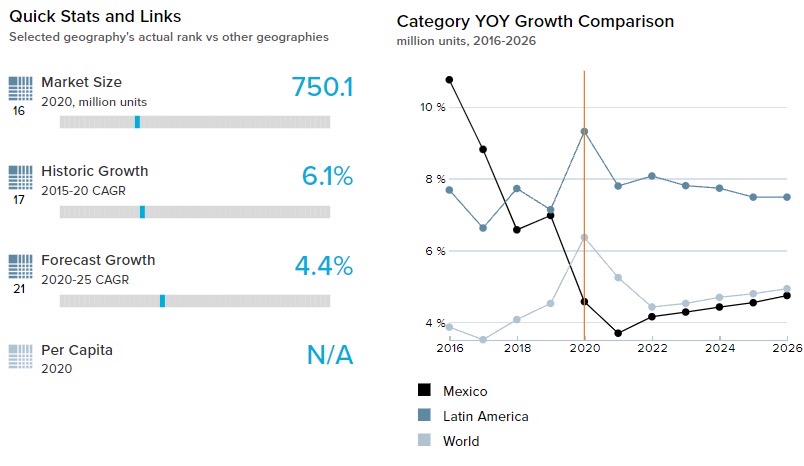
- The growing trends towards healthy living and clean labeling in human food are resonating with pet food as well, as pet owners become more aware of the importance of nutrients for their pets. As a result, pet owners are demanding high-quality brands of pet food that cater to specific needs. The manufacturers’ interest in premium dog and cat food means they are seeking to use packaging that preserves the food’s prime quality and important nutrients. Therefore, stand-up pouches are preferred to metal food cans because they are lightweight and compact, preserve the contents in an optimal condition, and as a result, showed a volume CAGR of 11.1% over 2015-20.
- The popularity of smaller pets, such as cats, is growing in the country as these pets have smaller appetites and are more affordable to maintain. Small-sized pet food packets can be sufficient for daily usage. Since COVID-19 induced economic recession made consumers price-conscious, the popularity of smaller pets has grown significantly in 2020. As a result, affordable pack types such as flexible packaging have managed to outperform traditional packaging formats such as metal food cans and register a volume growth of 5.1% in cat food during the year.
- Trends
-
- There is a trend of pet humanization among high-income consumer groups that led to the demand for high-quality brands of pet food that cater to specific needs. To keep the food fresh and maintain the quality, manufacturers are choosing zip/press closures as it prevents the exposure of food to moisture and helps preserve dog and cat food in optimal condition. As a result, zip/press closures showed a volume growth of 5.1% in 2020.
- More consumers are ordering pet food from e-commerce websites as it reduces their trips to the market and helps them save money through various discounts and offers. This resulted in a volume growth of 1.0% of flexible aluminum/plastic packaging in 2020, due to the ease with which it can be transported.
- Outlook
-
- Despite a decline in dog and food packaging in 2020, it is expected to grow at a CAGR of 6.0% in volume terms over 2021-25. The increasing pet population, coupled with humanization and health trends, is leading this growth in dog and cat food.
- Younger pet owners are displaying a greater propensity to feed their pets prepared food and are demanding more of those options which are natural, organic, or grain-free and are available in several retail channels. Therefore, those pack types which help keep food fresh, such as flexible plastic and metal cans, are expected to show a strong CAGR of 5.8% and 5.3% respectively in volume terms over 2020-25.
Click here for more detailed information from Euromonitor on the Dog and Cat food Packaging industry
Beauty and Personal Care
- Overview
-

- Flexible Packaging Landscape
-
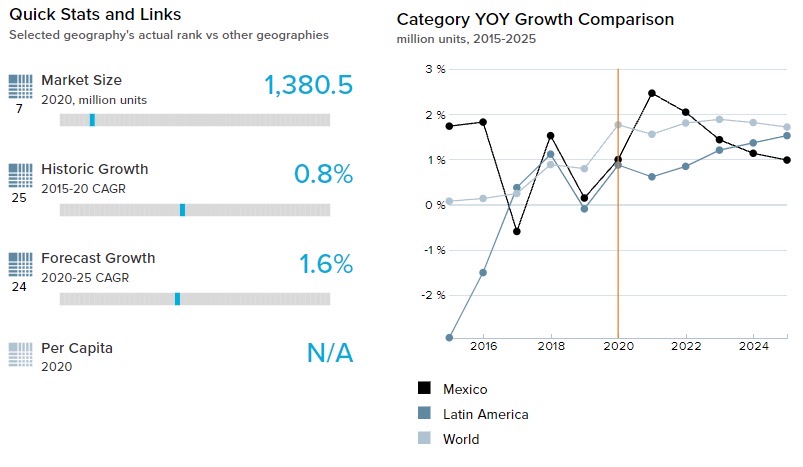
- Beauty and personal care packaging saw a volume decline of 2.1% in 2020. However, flexible packaging grew by 1.0% in volume terms in 2020, primarily due to the boost in sales of flexible paper/plastic packaging driven by growth in bath and shower products. Moreover, owing to its convenience of transportation, flexible paper/plastic grew 7.1% in volume terms in 2020.
- The impact of COVID-19 and the shrinking economy is amplifying consumer caution in spending. As a result, non-essential and high-priced beauty and personal care packaging categories such as color cosmetics packaging and fragrances packaging registered a volume decline of 19.0% and 15.8% respectively in 2020. This was further accelerated by lockdown measures, home seclusion, and reduced social interactions. Flexible packaging and rigid plastic declined 20.0% and 19.8% respectively in color cosmetics while glass and paper-based cartons both declined 15.8% in volume terms in fragrance packaging in 2020.
- Trends
-
- There is an increased focus on personal hygiene due to the pandemic, to which bath and shower products saw a boost in their sales, growing 13.0% in value terms in 2020. Flexible paper/plastic, which is the main type of this category, continues to maintain its dominant position with a volume share of 77.0% and volume growth of 7.1% in 2020.
- The closure of beauty salons and home seclusion measures made several Mexican consumers take to at-home beauty treatments, partly as a feel-good treat during times of anxiety and boredom. As such, the popular pack types of skincare, HDPE bottles and squeezable plastic tubes, showed a volume growth of 4.7% and 6.1% respectively in 2020.
- Outlook
-
- Consumers are shifting from premium brands to mass brands as COVID-19 induced uncertainty is expected to continue over 2021-25. Therefore, manufacturers will need to come up with creative packaging styles that can attract the consumers’ attention and help brands stand out from their competition.
- Sustainability concerns will likely continue to drive development throughout beauty and personal care packaging. Those pack types that can be recycled are expected to perform well. Another option that is expected to be adopted by the niche players in Mexico is refillable and reusable packaging formats, as it is a cost-effective method for the players to get noticed by the customers.
Home Care
- Overview
-

- Flexible Packaging Landscape
-
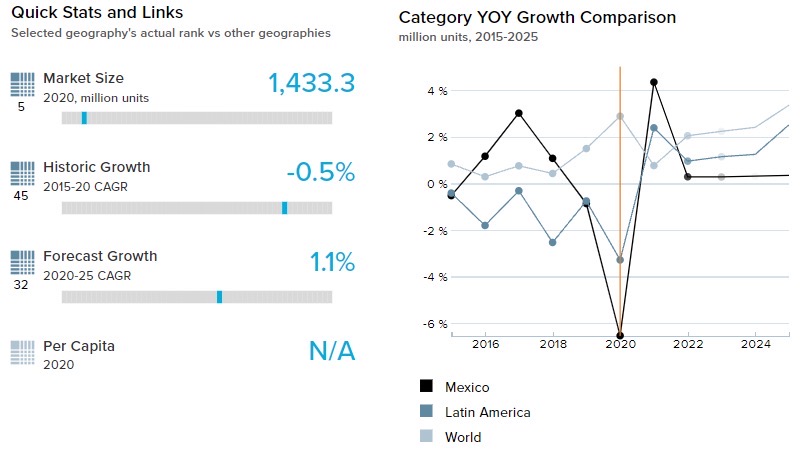
- The increased usage of utensils as people work from home boosted the sales of dishwashing products. As a result, the most commonly used pack types, such as flexible plastics and PET bottles, grew by 11.1% and 12.1% respectively in volume terms in 2020.
- Although there is a trend of launching larger pack sizes in the home care segment that offers better unit prices, many Mexicans cannot afford the cost of it. Therefore, smaller, and refillable packs are preferred, that are more accessible in terms of immediate cost.
- Trends
-
- The COVID-19 pandemic is making consumers more conscious about hygiene and cleanliness. Responding to this trend, companies expanded their capacity to manufacture more surface disinfectants and hygiene products. For example, Henkel launched its Persil Hygiene in Mexico t in 2020. This helped boost the sales of HDPE bottles which registered a volume growth of 6.0% in the surface care category in 2020.
- There is an increased focus on a circular economy in Mexico. As a result, brand owners are taking reusability and sustainability seriously. For example, in 2020, Unilever associated itself with Chilean company Algramo to reduce single-use plastic packaging, via the application of refills, for its detergents Quix and Omo.
- Outlook
-
- COVID-19 induced economic uncertainty coupled with the lockdown measures taken by the Mexican government made consumers more price sensitive. As a result, they are likely to be looking for cost-friendly pack types and not eco-friendly pack types that are expensive. This is expected to bring flexible plastic packaging into the picture, which is likely to show volume growth at a CAGR of 2.2% and 2.3% in laundry care and home insecticides respectively over 2021-25.
- More brands are expected to bring their businesses online as the popularity of e-commerce is increasing in Mexico. Therefore, plastic pouches and paper-based containers, which provide convenience in transportation, are expected to benefit from this trend. As a result, plastic pouches and paper-based containers are likely to grow at a CAGR of 2.3% and 1.6% respectively in volume terms over 2021-25.
Click here for more detailed information from Euromonitor on the Home Care Packaging industry
Packaged Food
- Overview
-

- Flexible Packaging Landscape
-
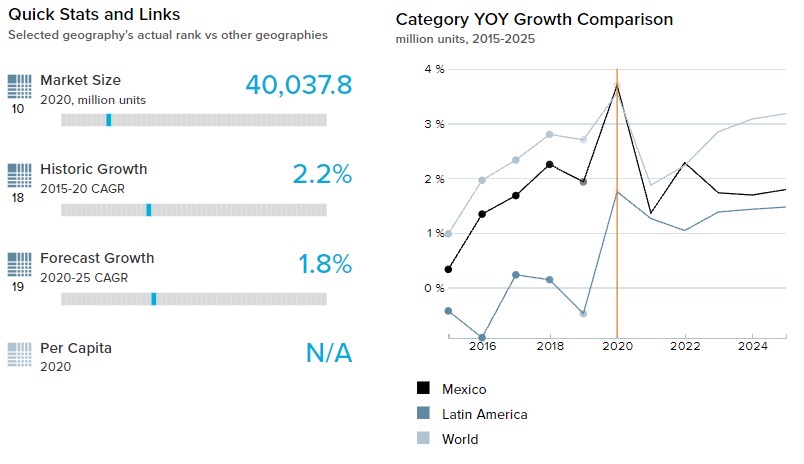
- Plastic pouches are an emerging pack type in confectionery, as it helps brands stand out. This is because they allow for high graphics to catch the consumers' attention and they can also come in various shapes and sizes. Many leading brands, such as Hershey's Kisses and Mars’ M&Ms, adopted this pack type to catch the customers’ eye. As a result, plastic pouches showed a volume growth of 9.2% in 2020.
- COVID-19 provided a modest boost for demand for processed meat and seafood packaging during 2020 driven by the demand of shelf-stable seafood which is regarded as a healthy source of protein. In processed meat and seafood packaging, flexible pouches and flexible aluminum/plastic grew significantly in popularity, showing volume growth of 5.8% and 7.5% respectively in 2020.
- Trends
-
- Obesity is a major public health concern in Mexico. As such, there is a shifting trend toward the consumption of healthier drinks and food. The onset of COVID-19 amplified this focus and increased the sales of drinking milk products. Brick liquid cartons, which are the main pack type of the category, showed a volume growth of 3.9% in 2020.
- Despite the fertility rate declining in Mexico, the demand for baby products remains robust, driven by the boost in sales of prepared baby food. This is due to the increase of the female labor force, with mothers relying more on prepared baby food to save time and effort. In this category, glass bottles continue to keep their dominant position having a volume share of 93.1% in 2020.
- Outlook
-
- Increased female participation in the labor force and the shrinking household size will be the key drivers for the expected growth of ready meals over 2021-25. The leading subcategories, chilled ready meals and dried ready meals, will help increase the demand for flexible plastic, which is likely to grow at a CAGR of 9.4% in volume terms over 2021-25.
- Mexico has an extremely high obesity rate and the pandemic heightened the awareness of the health risks associated with this chronic condition. Therefore, sugary products like gum will decline over 2021-25. As a result, flexible aluminum/paper which is the main pack type in which gum is packaged is expected to decline, with a CAGR of -6.2% in volume terms over 2021-25.
Click here for more detailed information from Euromonitor on the Packaged Food Packaging industry
RECOVERY FROM COVID
- Overview of COVID-19 conditions in Mexico
-

The National Health Council will soon announce the end of the pandemic in Mexico
- According to the World Health Organization (WHO), Mexico recorded 57,59,773 confirmed COVID-19 cases, with 3,24,768 deaths as of May 26, 2022.
- According to The National Law Review, in March, the country’s federal government indicated that the National Health Council will announce the end of the pandemic in Mexico. As the number of cases is beginning to wane, the government plans to designate 31 states with green status under the bi-monthly pandemic monitoring system. States in green status are allowed to operate without COVID-19-related restrictions. Queretaro is the only state on yellow status. States under yellow status are directed to operate with limited on-site business to curb the spread of the virus.
- Commercial flights are operational in the country. A negative COVID-19 test is not mandatory for entry. Passengers at Mexican airports may have to go through health screenings and temperature checks, for example, as a precautionary measure. Visitors exhibiting symptoms of COVID-19 may be subjected to additional health inspections and/or quarantine.
- As per the WHO, 79,947,470 Mexicans have been fully vaccinated and 53,001,421 people have had an additional booster dose in the country as of May 2022.
The chart below shows Euromonitor International’s Recovery Index.
The quarterly reported Recovery Index is a composite index that provides a quick overview of economic and consumer activity. It keeps track of the latest quarterly economic/consumer data and forecasts in key economies to gauge when economic activity and consumer demand are likely to return to the pre-pandemic levels of 2019.
A score of 100 and over indicates a full recovery in which economic output, the labor market, and consumer spending all return to/exceed 2019 levels.
Detailed methodology is provided in the Appendix.Quarterly Recovery Index and Related Indicators, Mexico

- Impact on GDP
-
This graph shows our "most probable" and "worst case" estimate scenarios of how COVID-19 will impact the real GDP value in Mexico. Our "most probable," or Baseline scenario, has an estimated probability of 45-60% over a one-year horizon. Our "worst case," or Pessimistic scenario, has an estimated probability of 13-23% over a one-year horizon. For more details, please refer to the detailed explanation of the COVID-19 scenarios in the Scenario Definitions section.
Please note that the forecasts will be adjusted every three months, according to the expected number of cases, recoveries, and deaths due to COVID-19 in this country, as well as shifting socioeconomic conditions (the most recent update was May 2022).
Baseline forecast refers to the "best case" COVID-19 scenario forecast that has an estimated probability of 45-60%.
C19 Pessimistic refers to the "worst case" COVID-19 scenario forecast that has an estimated probability of 13-23%.
Mexico’s economic performance is anticipated to lag in the medium term
- Witnessing a contraction of 8.2% in 2020, the annual real GDP in Mexico increased by 5.0% in 2021. Elevated private spending and gross fixed capital formation (GFCF) supported Mexico’s economy in 2021. Mexico’s economic performance is anticipated to lag behind the regional and global averages in the medium term, owing to low productivity and the energy sector’s expected underperformance, which is held back by a lack of reforms.
- The Mexican government’s statistics revealed that inflation rose swiftly in February 2022 and touched 7.3%, which is twice the central bank’s target range of 0% ± 1.0%. One of the deterrents that is responsible for elevating inflation in the country is Russia’s invasion of Ukraine. This is creating a dilemma for Banxico, the Bank of Mexico, which is compelled to increase the interest rate to control inflation without severely impacting the economic performance of the country. In February 2022, Banxico raised the benchmark interest rate by another 0.5 percentage point, owing to accelerated inflation. This is the sixth consecutive rate increase in the country.
- Following a dip in 2020, the international merchandise trade witnessed a strong recovery in 2021. In 2021, the export of goods accounted for 38.1% of Mexico’s GDP, outperforming the regional average of 22.6%. The export of goods from Brazil, for example, only made up 17.4% of the country’s GDP in 2021. Machinery and electronic equipment was the largest export category in 2021, accounting for 35.6% of Mexico’s total export value. The U.S. remained the main export partner of the country in 2021, with 94.9% of goods exported to the U.S. The US-Mexico-Canada (USMCA) trade deal following Trump-imposed import tariffs in 2018 strengthened trade relations among former NAFTA countries, supporting foreign demand for Mexican goods.
- Impact to Sector Growth
-
Please note that the forecasts are adjusted every three months according to the expected number of cases, recoveries, and deaths due to COVID-19 in the country, as well as shifting socioeconomic conditions.
The graph below displays the adjusted forecasts of the percentage growth for the categories mentioned to highlight the impact of COVID-19 between our pre-COVID-19 estimates and the "most probable" (Baseline) forecast which has an estimated probability of 45-60%.

Baseline forecast refers to the "best case" COVID-19 scenario forecast that has an estimated probability of 45-60%.
New labeling regulations for packaged food and non-alcoholic beverages are expected to influence consumers’ buying decisions
- Demand for home care products is expected to see stable growth in 2022. Factors such as a gradual recovery of consumers’ incomes, coupled with Mexicans’ continued focus on keeping their homes sanitized and clean will boost the retail sales of home care products (for example, surface care and air care) that claim to eliminate bacteria and viruses. Liquid tablet detergents, concentrated liquid detergents, etc., are also anticipated to perform well in 2022. The increasingly busy lifestyles of consumers will make them search for time-saving products that facilitate cleaning. As per Euromonitor’s Baseline scenario, expectations are that the retail sales of home care products will increase by more than 4% over 2019-2022.
- Mexico launched new labeling regulations for packaged food and non-alcoholic drinks in October 2020. These regulations make it mandatory for companies selling products with high-calorie content, saturated fat, and/or sodium to carry a black seal on the packaging. In addition, manufacturers are required to reveal on the packaging if their product makes use of artificial sweeteners and if that is the case, to mention clearly that the consumption of these may be detrimental to children’s health. This accelerated the demand for hot drinks as health-conscious consumers avoided the consumption of unhealthy soft drinks carrying the black seal. As per the Baseline scenario, it is anticipated that the retail sales of hot drinks will increase by more than 10% over 2019-2022.
- The third wave of the COVID-19 pandemic in 2021 benefited the demand for sauces, dressings, and condiments in Mexico as home cooking remained popular among consumers. Several brands launched new products to meet increasing consumer demand for this category. For example, in 2021, the leading cream cheese brand, Philadelphia, launched dips in different flavors: chipotle, cream, and a blend of spices. By 2022, the demand for products, such as dips and chili sauces, is expected to soar as social gatherings increase. Expectations are that the retail sales of cooking ingredients and meals will increase by more than 12% over 2019-2022.
Please note that the forecasts are adjusted every three months according to the expected number of cases, recoveries, and deaths due to COVID-19 in the country, as well as shifting socioeconomic conditions.
This graph shows our "most probable" and "worst case" estimate scenarios of how COVID-19 will impact the percentage growth for the sectors mentioned in Mexico. Our "most probable," or Baseline scenario, has an estimated probability of 45-60% over a one-year horizon. Our "worst case," or Pessimistic scenario, has an estimated probability of 13-23% over a one-year horizon.

Baseline forecast refers to the "best case" COVID-19 scenario forecast that has an estimated probability of 45-60%.
C19 Pessimistic refers to the "worst case" COVID-19 scenario forecast that has an estimated probability of 13-23%.
The growing emphasis on health and personal hygiene is likely to influence consumers’ buying decisions
- The pandemic and subsequent lockdowns largely hampered the sales of tobacco in Mexico in 2020. The reduced purchasing power of consumers and increasing unemployment in 2020, in addition to the rise in the price of cigarettes as a result of the government’s 2020 update to the IEPS for tobacco, affected the ability of low- and mid-income consumers to purchase tobacco. The IEPS (Impuesto Especial de Productos y Servicios) is a tax that is imposed by Mexico’s federal government on products that are deemed to be harmful to the population. Tobacco lost popularity among Mexican consumers in 2021 as well, as rising health consciousness coupled with various reports claiming that smoking has the potential to exacerbate COVID-19 symptoms, discouraged Mexicans from purchasing tobacco. As per the C19 Pessimistic forecast scenario, it is anticipated that retail sales of tobacco will decrease by more than 8% over 2019-2022.
- The continued emphasis on maintaining personal hygiene is expected to increase retail sales of tissue and hygiene products in 2022. For example, the demand for menstrual hygiene products, such as tampons and menstrual cups, is likely to increase in 2022 owing to this reason as well as the new zero percent tax regulation on feminine hygiene products in 2022. The demand for AFH tissue products is also expected to accelerate in 2022 as the number of COVID-19 cases begins to wane in the country, thereby increasing outdoor mobility. According to the C19 Pessimistic forecast scenario, expectations are that retail sales of tissues and hygiene products will increase by more than 8% over 2019-2022.
- Impact on Flexible Packaging
-
The following tables display adjusted market size for 2021, market size forecasts for 2022, and the percentage difference between the February 2022 and June 2022 estimates for the year 2022.
Please note that for the current quarterly update, the following table covers beauty and personal care packaging and home care packaging industries only.
Packaging Industry
2021 market size as per Jun 2022 data
2022 market size as per Jun 2022 data
% Difference between Jun 22 and Feb 22 data for 2022
Beauty and Personal Care Packaging
4,874
4,974
0.5
Home Care Packaging
3,875
3,933
-4.2
Packaging Type
2021 market size as per Jun 2022 data
2022 market size as per Jun 2022 data
% Difference between Jun 22 and Feb 22 data for 2022
Rigid Plastic
33,995
34,368
-0.18
Flexible Packaging
44,657
44,896
-0.22
Metal
15,313
15,549
0.01
Paper-based Containers
6,546
6,668
-0.08
Glass
16,502
17,020
0.14
Liquid Cartons
5,551
5,500
-0.04
Flexible plastic gains popularity in dog and cat food, as well as meat and seafood packaging
- Mexico officially banned single-use plastics such as straws, cups, etc., in 2021. With the increased focus on switching to sustainable production practices, further regulations regarding the use of plastics are expected to be introduced in Mexico. Brands in soft drinks are thus expected to seek more environmentally-friendly packaging formats. This is expected to benefit glass packaging in 2022, as glass is a fully recyclable material.
- Flexible packaging grew in popularity in dog and cat food packaging in 2021. In wet dog and cat food, stand-up pouches gained ground over metal food cans as they are light and compact. In addition, stand-up pouches come with resealable zip/press closures that keep the treats fresh for a longer duration. In dry dog and cat food, such pack types gained popularity as they are easy to transport and handle.
- Plastic pouches gained popularity in processed meat and seafood packaging in 2021. This pack type attracted consumers looking for convenience. There was accelerated demand for sliced chilled processed meat in plastic pouches with re-sealable closures in 2021 as this pack type helps maintain the freshness of the product. The demand for this packaging format further witnessed an increase in shelf stable seafood owing to its availability on e-commerce platforms, which became a popular distribution channel among consumers.
- Definitions
-
- Beauty and Personal Care Packaging: This is the aggregation of packaging for baby care, bath & shower products, deodorants, hair care, color cosmetics, men's grooming products, oral hygiene, perfumes & fragrances, skin care, depilatories and sun care. Black market sales and travel retail are excluded.
- Dog and Cat Food Packaging: This is the aggregation of dog and cat food packaging.
- Packaged Food Packaging: This is the aggregation of packaging for baby food, Bakery, canned/preserved beans, canned/preserved fish/seafood, canned/preserved fruit, canned/preserved meat and meat products, canned/preserved tomatoes, canned/preserved vegetables, other canned/preserved food, confectionery, chilled fish/seafood, chilled lunch kit, chilled processed meats, fresh cut fruits, dairy, dessert mixes, rice, frozen bakery, frozen desserts, frozen meat substitutes, frozen processed fish/seafood, frozen processed potatoes, frozen processed poultry, frozen processed red meat, frozen processed vegetables, other frozen processed food, ice cream, meal replacement, noodles, oils and fats, pasta, ready meals, sauces, dressings and condiments, snack bars, soup, spreads and sweet and savory snacks.
- Home care Packaging: This is the aggregation of packaging for laundry care, dishwashing products, surface care, chlorine bleach, toilet care, polishes, air fresheners and insecticides.
- Beverages Packaging: Beverage packaging is the aggregation of alcoholic drinks packaging, hot drinks packaging and soft drinks packaging.
- Scenario Definitions
-
Scenario Assumptions
Baseline
C19 Pessimistic
Estimated probability
45-60% over a one-year horizon
13-23% over a one-year horizon
Global GDP growth
2.0% to 4.0% in 2022
1.8% to 4.2% in 2023
-1.0% to 1.0% in 2022
-0.5% to 2.0% in 2023
COVID-19 situation
A combination of high vaccination rates with milder virus variants and widespread availability of antiviral drugs make COVID-19 an endemic disease in advanced economies.
The spread of a more infectious and highly vaccine resistant COVID-19 mutation requires intense lockdowns/social distancing measures in 2022-2023, delaying the economic recovery from the pandemic
Vaccinations
Existing vaccines remain highly effective against severe disease from new coronavirus variants, with moderate vaccine modifications.
Vaccination campaigns progress in developing economies is slower than expected.
Impact on economy
Services activity would pick up in 2022 on the back of loosening COVID-19 restrictions and released pent-up demand.
Longer lasting and much stricter distancing measures cause large drops in consumption, business revenues, employment and wages relative to the baseline forecast in 2022-2023.
- Recovery Index
-
Recover Index Methodology
Euromonitor International's Recovery Index is a composite index that provides a quick overview of economic and consumer activity and helps businesses predict recovery in consumer demand in 48 major economies. The index takes into consideration total GDP and factors that determine consumer spending - employment, consumer spending, retail sales, and consumer confidence. Index scores measure the change relative to the average per quarter for 2019.
Category
Weighting
Focus
Economic Activity
20%
Tracks and forecasts the level of real GDP, as this is a broad measure of everything that workers and capital produce in a country.
Employment
20%
Looks at the employed population and average actual weekly working hours in each quarter, as these indicators help track households' primary source of income besides government financial support.
Consumer Spending
25%
Looks at private final consumption expenditure in each quarter, as this is officially the best measure of consumer spending in real terms.
Retail Sales
25%
Focuses on seasonally adjusted real retail sales data as a timely indicator of economic performance and strength of consumer spending.
Consumer Confidence
10%
Looks at the standardized consumer confidence index to see how consumers across countries feel about their situation and when they will start feeling better about the future.



